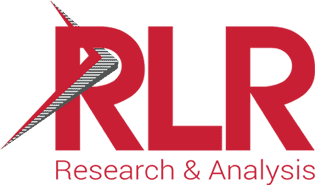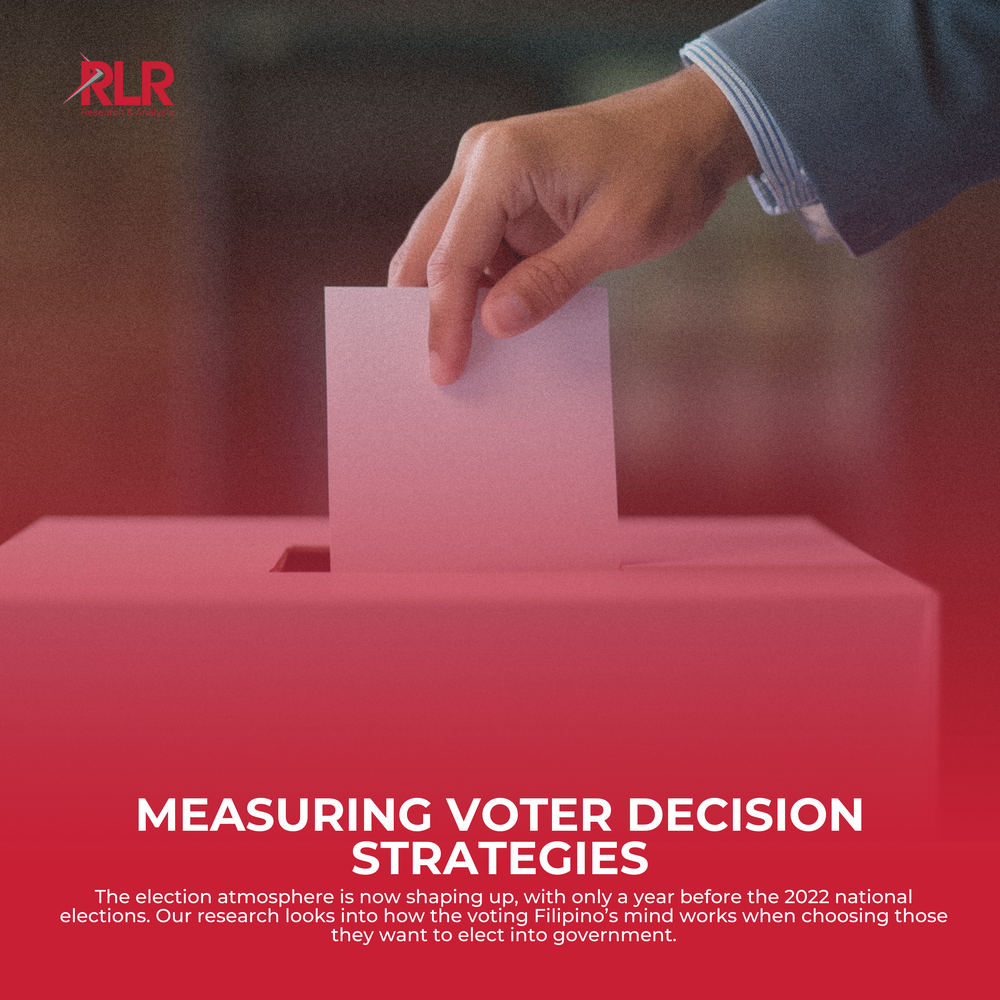
“The election atmosphere is now shaping up, with only a year before the 2022 national elections. Our research looks into how the voting Filipino’s mind works when choosing those they want to elect into government”

5 Voter Decision Strategies
“These results show the diverse methods Filipino voters employ when choosing a candidate. Understanding the mind-set of voters will be essential to see the trends in the upcoming polls”

PRESS RELEASE MAY 2021
ALMOST HALF OF FILIPINO VOTERS ARE BIASED DECISION MAKERS
45% or 20.5 million of Filipino voters rely on scant information, and do away with thorough consideration of alternatives when choosing candidates to cast their ballots for, a survey conducted by RLR Research & Analysis, Inc. (RLR) shows.
The research reveals that nearly half of the voting population considers word of mouth information, and party affiliations as relevant factors in picking a political candidate. Likewise, majority of voters will base their decisions on their gut-feel about a candidate come election time.
“The election atmosphere is now shaping up, with only a year before the 2022 national elections. Our research looks into how the voting Filipino’s mind works when choosing those they want to elect into government,” Joel Flores, RLR Polling and Social Team Head said.
Of the 20.5 million voters, 6.4 million are classified as Heuristic-based decision-makers by the study. The research firm depicts them as generally motivated to make good decisions and choosing to arrive at such a decision as easily as possible. They are quick to drop alternative candidates as soon as any negative news is heard about them. They are mostly influenced by what they know about their candidates and word of mouth. Heuristic-based decision makers are prone to being swayed by fake news.
Also according to the study, 5.9 million voters use confirmatory decision making. The research body describes confirmatory voters as those who value the personality and party affiliation of a candidate. Theirs is more of a passive way of information gathering and they are typically selective with the data they consume. Data which are often skewed towards their favored party or candidate.
Completing the 45% of biased decision-makers are the 8.2 million that are tagged by the study as gut decision-makers. These are voters who are not inclined to search for information about any candidate. They are less inclined to actively gather information about alternatives. Choices about candidates are made on the premise of how they make gut decision-makers feel, the study says.
The survey aims to uncover strategies Filipino voters use to reach their decisions on whom to vote for in the elections. This in turn can show potential trends in voter preference in the elections.
“We found that majority of voters depend on thinking strategies that help them arrive at their candidate of choice. We also found that respondents mentioned the following, among others, as factors affecting their choices: policy stands of candidates or their parties; past performance in office, particularly for re-electionists, characters of candidates, and social identifications and associations, particularly political alliances of candidates,” Flores said.
Meanwhile, the survey has also shown that approximately 16 million voters or 34% of the voting population are conscientious with regards to collecting information about candidates.
“This one-third of the population will responsibly spend time and effort to arrive at an informed decision. They can be described as ideal voters,” Flores said.
The poll shows that, 9.3 million can be classified as rational choice voters. These voters actively gather as much information about election candidates. They weigh the positive and negative attributes of each candidate and base their decision on balanced choices.
Rounding up the five thinking strategies are the fast and frugal decision makers, who comprise 6.7 million of the voting population. They are mostly motivated by efficiency, seeking information that will help them arrive at a correct choice quickly. Fast and frugal voters are typically influenced by what is on news media. They also consider the campaign platforms of candidates, and will likely choose a candidate that can provide what they particularly need.
“Yet, the survey also shows that there are still 10.3 million voters or 22% of the population that show no distinct pattern of decision-making. They tend to shift from one strategy to another without deliberate thought.” Flores said.
Survey respondents classified as “Unpredictables” by the study have likewise been noted to be more prevalent in the rural areas. They are considered as impulsive decision-makers resorting to the use of different thinking strategies for various scenarios.
Meanwhile, respondents situated in urban areas are noted to be more inclined to gather information about candidates.
“These results show the diverse methods Filipino voters employ when choosing a candidate. Understanding the mind-set of voters will be essential to see the trends in the upcoming polls,” Flores said.
The research firm conducted the survey fieldwork from February 25 to March 8, 2021 using face-to-face interviews. The study had 1,500 respondents nationwide composed of 300 respondents each from the National Capital Region, North and Central Luzon, South Luzon, Visayas and Mindanao. Likewise, all respondents are 18 years of age and above, registered voters, and with intention to vote in 2022. All eco-classes are represented in the study.
“This study opens a host of opportunities for finding out the behavior and needs of the voting population to be able address those needs,” Flores said.
About RLR Research & Analysis, Inc.
RLR Research & Analysis has been undertaking market research studies since 2013. The company’s research specialization lies in automotive, healthcare, and polling among other industries. Its studies and recommendations have been behind the market positioning of some of the most prominent brands, personalities, local and multinational corporations and organizations.
The company’s core services include: Market Research, Business Intelligence, Consulting, Data Management and Operations, Data Management and Analysis, Polling and Public Opinion, Consumer, Automotive and Social Research.
It is dedicated to providing its clients with ethical and best-in-class research, strictly adhering to the Code of Professional Ethics and Practices set forth by the Marketing and Opinion Research Society of the Philippines (MORES).
The RLR office is located 4F Kalayaan Center in Diliman, Quezon City and can be reached at (632) 7750-0944 (local 103). For inquiries, contact MR. JOEL FLORES (joel@rlrresearch.com) or MS. ABI QUIJANO (abi@rlrresearch.com).









